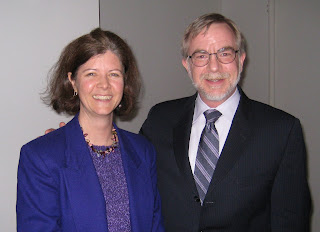 This week's guest for Flooring The Consumer's Social Media Series: Bridging New & Old is Beth Harte.
This week's guest for Flooring The Consumer's Social Media Series: Bridging New & Old is Beth Harte.Beth Harte exudes passion and connection. It's palpable on her blog, The Harte of Marketing, in her posts at Marketing Profs’ Daily Fix and also in her role as Community Manager for MarketingProfs. She connects people and ideas, not just in person or via email, but also via Twitter [@BethHarte], on the MarketingProfs LinkedIn Group and Facebook Fan Page, on blogs - and anywhere else where relevant conversation takes place. Inevitably, she nurtures the conversations and interactions and adds unexpected perspectives.
Beth also bridges conversation with discipline.
Take her recent online seminar for the MarketingProfs Summer Series: Getting Buy-in with Social Media Measurement: Don't Sweat the Small Stuff. Yes, it was packed with insight and sound perspective on her social media experiences, but she also brought up the structured and strategic thinking that marketers need to put into practice for success. For that matter, check out her posts on The Search Engine Guide Blog.
Beth Harte is a consummate PR professional who launched the weekly PR 2.0 Chat on Twitter back in May 2009 [ look for #PR20Chat on Wednesday evenings from 8-9+ pm EST.] She and others moderate the discussions that range from the nature of public relations 2.0 to branding to measurement to... Have you checked it out?
In addition to her roles as marketer, blogger, speaker, communicator, thinker, connector (people & dots), Beth is also adjunct professor at Immaculata University. I can imagine how thought-provoking her classes are!
C.B.: Beth, how and why did you get involved in social media?
Beth: I’ve always been a really social person and my claim to fame in school was always the one being caught for passing notes! Not much changed in college, graduate school and my career. Well, except the getting caught part and the fact that now all of those notes are electronic.
In 2004, I joined a couple of online Yahoo! Groups dedicated to one of my favorite brands, Hermès. And yes, believe it or not, there are about three online communities dedicated to the brand. Joining these groups was my first exposure to “social media/networking.” We didn’t call it social media/networking, it was just a group. I got involved in the groups because I wanted to learn more about the brand, the scarves, the artists who designed the scarves, etc. and within the group I could do it freely. As well, at the time brands like Hermès didn’t participate in social media so other people were the source of knowledge about the brand.
Being engaged in social media as a brand enthusiast and consumer versus a marketer gave me a TON of insights that I would have never been able to get as a marketer. That’s why I always suggest to marketers who want to really understand social media that they join a community, group, or forum based on a hobby, brand they like or sport. Doing so forces you to engage as a ‘person’ rather than a corporate or brand talking head. As well, the interesting group dynamics are really visible when you are interacting as a person. You learn who the opinion/thought leaders are, who the trouble makers are, who the fun people are, who the tolerant people are, who the helpful people are, etc. Understanding sociology as well as marketing is a definite plus when it comes to engaging in social media.
We also met as a group offline too for lunches, shopping, etc. It really helped solidify relationships with each other and sales associates in the Hermès boutiques. And no matter where you were in the country/world, there was always someone to meet up with!
I started blogging in 2006 because it was a way for me to share my thoughts, opinions, experiences, etc. It was a non-marketing blog, which was a great precursor to my current blog, The Harte of Marketing.
C.B.: What do you like most about social media?
Beth: Social media (the tools) like Twitter, groups, blogs, forums are my conduits to meeting people, learning, and sharing. I have met so many great marketers from all over the world, it’s really amazing. Social media (the concept) for me is about being free to be me in a way that’s natural to me. Like I said, I’ve always been a social person so, to learn that it’s okay to be professional and personable at that same time is refreshing. I don’t separate “Beth Harte the marketer” from “Beth Harte the person.” They are one in the same and I appreciate being able to speak like a “human” vs. corporate marketing speak.
C.B.: What do you like least about social media?
Beth: What I struggle most with social media is that it gets represented as replacing traditional marketing or that it’s an all or nothing option. I don’t believe either is true. When people talk like that, it really makes me wonder if they understand business or marketing. I am also often frustrated by people who liken social media to just another channel where marketing messages can be dumped. This might work for some brands, but when I hear about brands that ignore people trying to reach out to them, it really makes me wonder what their motives are for engaging in social media in the first place.
C.B.: How has social media changed how you interact with the marketplace as a consumer or customer?
Beth: It hasn’t. I guess I am a marketing purist... But when my very first marketing professor drilled into my head “know thy audience” I took it to heart. And the only way you can know them is to speak with them (and I don’t mean marketing research). I’ve always been a huge proponent of interacting and getting to know customers. I am just happy that social media is finally making customer relationships and conversations the norm versus something taboo. And, of course, I am thankful to have a job where I am expected to engage/interact with members all the time.
C.B.: What 5 suggestions do you have for companies to implement so they can more effectively bridge old media with new media and connect with end users?
Beth: I am one for simplicity and I think folks are making marketing AND social media (the concept) overly complicated, so here’s a short list:
1. Research (Know thy audience)
2. Listen (Where are they congregating? What are they talking about? Who do they talk to? Do they like email and Twitter? Perhaps events and Facebook are the way to go...)
3. Benchmarks and/or KPIs (Where are you? Where have you done? What have you achieved?)
4. Plan (Have a plan that includes a goal, measurable objectives, strategies and tactics laid out before diving in! Then stick to the plan...only making adjustments when/where necessary.)
5. Interact (if your plan includes social media then BE social. It’s okay, really, to be professional and personable at the same time)
6. Rinse, wash, repeat
C.B.: Any other thoughts to share about the effectiveness of social media in forging stronger relations with customers and how best to do so?
Beth: Keeping with the simplicity theme, I think some people want to have relationships with brands they like and spend money with. Other people could care less about engaging brands. I think it’s important for organizations to know the difference so that they know where to spend their time. I think an honest relationship, where you aren’t always seeking something in return, lends itself to customers who want to stick around longer. That said, I also think it’s important to know when to have a line in the sand. While it’s wonderful to have relationships with customers, there will always be customers who take advantage of relationships...sometimes they are right to do so and sometimes they aren’t.
Thank you, Beth!
Comments? Questions? Feedback?
What do you connect with? Some of my takeaways from Beth's comments are:
+ "I always suggest to marketers who want to really understand social media that they join a community, group, or forum based on a hobby, brand they like or sport. Doing so forces you to engage as a ‘person’ rather than a corporate or brand talking head."
+ The only way to 'know thy audience' is to speak with them.
+ It's important for organizations to understand whether their audiences want to have a relationship or not so they know where to spend their time.
It should come as no surprise that I greatly appreciate Beth's focus on 'simplicity!'
For additional insights from other participants in the Social Media Series: Bridging New & Old, please visit The Entire Bridging New & Old series, which includes a link to the e-book based on the first 26 interviews in the series.
Technorati Tags: Beth Harte Harte of Marketing MarketingProfs community manager bridging new & old social media series social media marketing Del.icio.us Tags: Beth Harte Harte of Marketing MarketingProfs community manager bridging new & old social media series social media marketing










